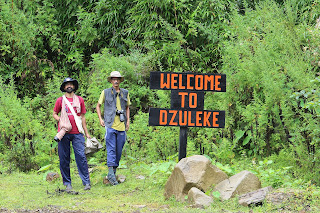On
that deserted road in the far-flung hill ranges, three of us were
engaged in butterfly watching. One side of the serpentine road had
thick low lying vegetation while on the other side, sharp hill
slopes. A signboard painted in dark orange assured that we had
reached the entrance of Dzuleke, our destination 40 km away from
Kohima, the capital of Nagaland and 20
km away from Khonoma, where we
were staying for the last couple of days. The road and surroundings
were drenched due to drizzle that accompanied us all the way from
Khonoma. As we informed the main intention of the trip, our friendly
driver stopped the vehicle near a stream crossing the road just after
a sharp curve. The number of butterflies was very less in that wet
and cool climate. After a preliminary observation in the vicinity of
the stream-side, each one of us walked towards different directions
for a chance to find out some butterflies around.
 |
| On the way to Dzuleke |
